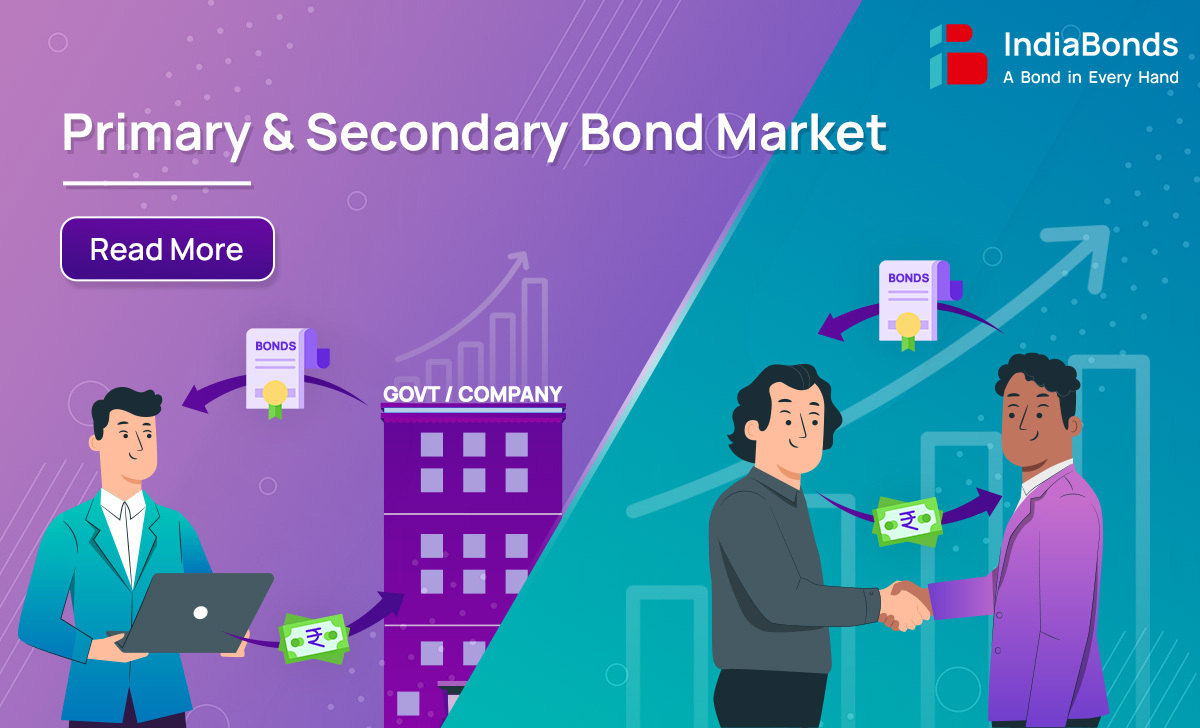Difference Between Primary and Secondary Market

Introduction
In the financial ecosystem, new and various types of financial instruments are regularly issued to the public to suit their individual needs. When it comes to equity investing, one can buy and sell equities in primary and secondary market. The primary market is where securities are first issued, after which they are exchanged on the secondary market.
Bond markets are where investors can buy and sell various forms of debt securities, such as G-secs and debentures. This market, similar to equity, is also divided into two categories: primary and secondary bond market. Understanding the primary vs secondary market is essential for investors to make informed decisions.
What is the primary market?
Primary markets mean that market which allows sale of newly issued bonds. Newly issued bonds can be registered with the regulators for sale to the public (public offering) or sold only to qualified investors (private placement). Bonds are issued to the public for the first time in primary markets. However, secondary markets facilitate the trading of previously issued bonds. In simple words, primary market refers to the market where debt instruments are created, and the secondary market is the marketplace where investors trade these instruments.
Features of Primary Market
The debt primary market is where new debt securities are issued and sold to investors for the first time. In this market, the issuer of the debt security raises capital by issuing bonds, notes or other debt instruments. The investors receive an obligation of the issuer that the debt will be repaid, as well as a promise of interest payments over a predetermined time period-in exchange for the issuer receiving the money collected through the sale of the debt instruments.
Some of the key features of this market include:
- Regulated by the Reserve Bank of India (RBI) for government bonds and the Securities and Exchange Board of India (SEBI) for corporate bonds.
- Debt instruments are issued to the general public through public offerings or to a select group of investors through private placements.
- The market is highly organized with various intermediaries such as investment bankers, registrar, transfer agents and credit rating agencies playing a crucial role.
- The market provides an alternate source of funding for the issuers, besides equity and bank loans.
- The primary debt market in India is well-developed, with a range of debt instruments catering to different investor segments, tenors, and credit profiles.
What is the Secondary Market?
The secondary bond market is an essential component of the financial system where previously issued bonds are traded among investors. Unlike the primary market, where bonds are first issued directly from the issuer to investors, the secondary market facilitates the buying and selling of bonds among investors after the initial issuance. This market provides critical liquidity, allowing investors to freely enter and exit positions based on their financial goals and market conditions. It also plays an important role in price discovery, as the prices of bonds in this market fluctuate in response to changes in interest rates, economic indicators, and issuer creditworthiness. Regulated to ensure transparency and fairness, the secondary bond market is indispensable for both retail and institutional investors, offering a dynamic environment for managing bond investments over time.
Features of Secondary Market
The debt secondary market is where existing debt securities are bought and sold after they have been issued in the primary market. In the secondary market, investors can buy and sell debt securities, such as bonds and notes, without the involvement of the original issuer. The secondary market provides liquidity to investors, allowing them to buy and sell their holdings as needed, while also helping to determine the fair value of the securities based on supply and demand.
The secondary debt market in India refers to the market where existing debt instruments, such as G-Secs and NCDs, are bought and sold among investors. Some of the key features of this market include:
- Regulated by the Reserve Bank of India (RBI) for government bonds and the Securities and Exchange Board of India (SEBI) for corporate bonds.
- The market is highly organized with intermediaries such as stock exchanges, brokers, dealers and online bond platforms like IndiaBonds playing a crucial role.
- Debt instruments are traded on stock exchanges and over-the-counter (OTC) markets.
- The market provides liquidity to investors by allowing them to sell their debt instruments before maturity.
- The market provides investment opportunities to a wide range of investors, including individuals, institutional investors and foreign investors.




Difference between Primary and Secondary Bond Market
| Aspect | Primary Market | Secondary Market |
| Definition | Where debt securities are first issued. | Where previously issued securities are traded by investors. |
| Also Known As | New issue market. | After issue market. |
| Price Dynamics | Prices are set at issuance. | Prices fluctuate according to supply and demand. |
| Transaction Type | Investors purchase debt securities directly from the issuer. | Investors buy and sell securities among themselves. |
| Frequency of Sale | Securities can only be sold once. | Trading is a continuous process, allowing for buying and selling multiple times. |
| Flow of Funds | Proceeds go directly to the issuer. | Returns from trading go to investors and traders. |
| Coupon and Yield | Coupon and yield remain the same as they are fixed at issuance. | Yield can differ as prices fluctuate in response to market conditions. |
Understanding the primary market vs secondary market differences is key to tailoring your investment strategy as per your goals.
Advantages and Disadvantages of Investing in the Primary Market
| Advantages | Disadvantages |
| Direct purchase from the issuer, avoiding intermediaries. | Limited to new securities, reducing options. |
| Opportunity to invest early in companies with growth potential. | Risk of overpricing during IPOs. |
| Possibility of earning higher returns in the long run. | Lack of liquidity until securities are listed. |
While the advantages of investing in the primary market often appeal to long-term investors, the disadvantages of investing in the primary market should also be considered carefully before investing.
Advantages and Disadvantages of Investing in the Secondary Market
| Advantages | Disadvantages |
| High liquidity, enabling quick buying and selling. | Subject to market fluctuations and volatility. |
| Transparent pricing determined by demand and supply. | Risk of emotional trading due to frequent price changes. |
| Access to a diverse range of securities. | Brokerage fees and other transaction costs. |
While the advantages of investing in the secondary market lies in flexibility and liquidity, the disadvantages of investing in the secondary market include exposure to risks from market volatility.
Conclusion:
In conclusion, the debt market in India has been growing at a steady pace in recent years. The market offers a wide range of investment options for both retail and institutional investors and has been attracting a growing number of participants. The Indian government has been actively promoting the development of the debt market by implementing various reforms and initiatives to increase its depth and liquidity. The market has remained resilient, and experts believe that it will continue to grow in the coming years.
FAQs
Q. What is the difference between primary and secondary market?
A. The primary market is where fresh securities such as bonds or stocks are issued for the first time, directly from the issuer to investors. This is also known as the new issue market. Conversely, the secondary market is where these issued securities are subsequently traded among investors. This market provides liquidity and sets current pricing for the securities based on supply and demand.
Q. What is secondary market example?
A. An example of a secondary market is the stock exchange, such as the Bombay Stock Exchange (BSE) , where stocks, bonds, and other securities are bought and sold among investors after their initial issuance. These platforms facilitate the continuous trading of securities, providing investors the opportunity to realize gains or losses based on market conditions.
Q. What is meant by primary market?
A. The primary market refers to the segment of the capital market where new securities are created and offered for sale to the public for the first time. This can include public offerings in stock or bond issuances, where companies or governments raise capital directly from investors. The primary market enables issuers to receive funds directly from investors in exchange for securities.
Q. What is the role of SEBI in primary and secondary market?
A. SEBI plays a crucial role in both the primary and secondary markets by ensuring fair practices and transparency. In the primary market, SEBI administers the issuance of new securities, ensuring compliance with legal standards. In the secondary market, it regulates trading activities and market intermediaries, maintaining market integrity and protecting investor interests.
Disclaimer: Investments in debt securities/ municipal debt securities/ securitised debt instruments are subject to risks including delay and/ or default in payment. Read all the offer related documents carefully.













































